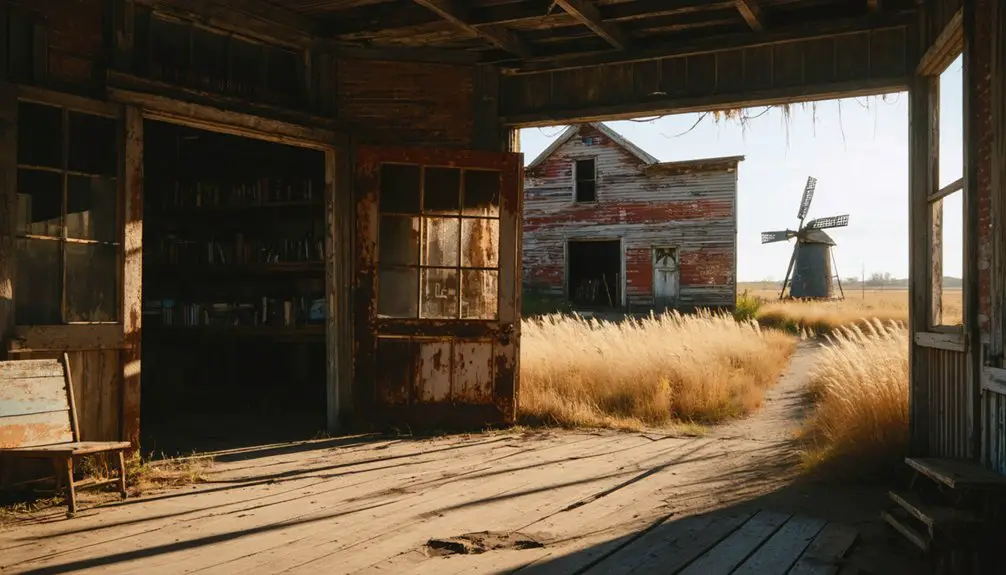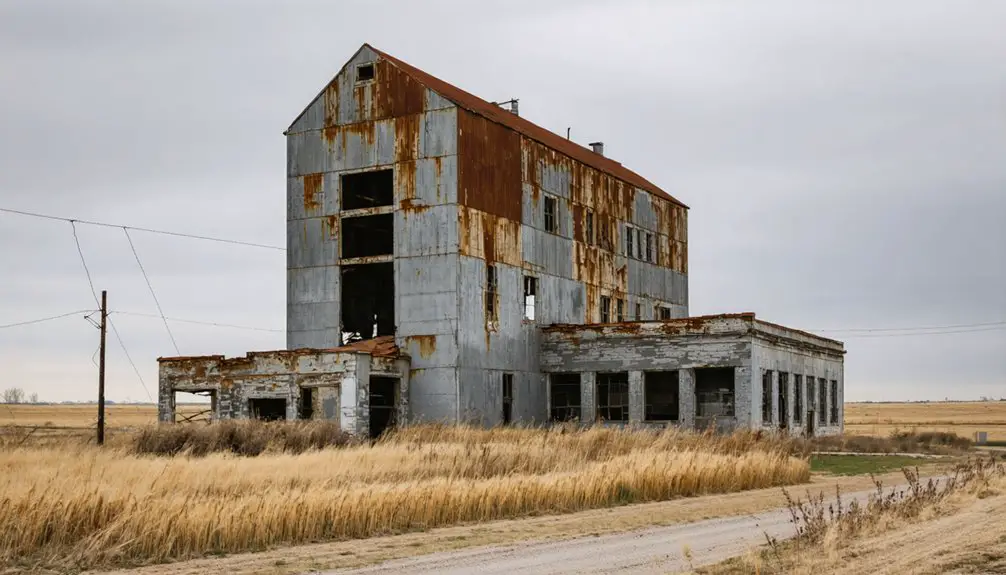You’ll discover Wolf, Oklahoma emerged during the late 1800s oil boom after crude was found in the Anadarko Basin. This once-thriving community centered around oil production, with wooden homes, general stores, and the Free Will Baptist church serving workers and families. When the wells started producing less, the town faced classic boom-bust decline as residents sought opportunities elsewhere. Today, preserved structures and digital archives tell the story of this frontier settlement’s rise and fall.
Key Takeaways
- Wolf emerged as an Oklahoma oil boom town in the Anadarko Basin, characterized by wooden homes and oil derricks during its peak.
- The town’s decline began when oil production decreased, leading to business closures and population exodus to urban areas.
- Community life centered around the Free Will Baptist church, local stores, and a schoolhouse before the town’s abandonment.
- Architectural remains from the late 1800s, including rustic barns and cabins, are preserved through stabilization projects.
- Digital preservation efforts document Wolf’s history through photographs, archives, and oral histories in the Ghost Towns In Oklahoma project.
The Birth of an Oil Boom Settlement
While Oklahoma was still Indian Territory in the late 19th century, the discovery of oil in Bartlesville in 1897 sparked a series of events that would lead to Wolf’s establishment. The town’s growth was aided by the Kansas, Oklahoma Central railway that enabled efficient crude transport.
As railroads pushed through the territory, bringing essential transportation links for crude oil, oil exploration spread rapidly across the region. Like the rise of Ranger and Electra, Texas oil towns earlier in the decade, you’d have witnessed Wolf emerge from undeveloped land as part of the broader Anadarko Basin developments, driven by ambitious wildcatters and oil companies racing to stake their claims.
The settlement growth exploded as drilling rigs sprouted up and support industries rushed in. Supply depots, equipment yards, and general stores quickly followed the influx of workers.
Wolf transformed into a bustling extraction hub, powered by the discovery of nearby fields like Glenn Pool and the promise of black gold beneath the Oklahoma soil.
Life During the Peak Years
Life in Wolf during its peak years painted a vivid portrait of America’s oil boom culture. You’d find yourself among a small but bustling community of oil workers and their families, living in modest wooden homes and temporary structures.
Your daily routines would revolve around the oil fields, where drilling and machinery maintenance dominated the workday. Like many other boomtown communities across Oklahoma, the town emerged rapidly following major resource discoveries.
From sunrise to sunset, oil field workers toiled with heavy machinery, their lives dictated by the rhythms of drilling operations.
Community interactions centered at the local saloons, general stores, and informal gatherings. Similar to towns like Whizbang and Three Sands, Wolf’s existence depended heavily on oil production success. You’d shop at small retail outlets for necessities, send mail at the post office, and perhaps attend religious services in multipurpose buildings.
While the town lacked modern amenities like electricity and proper sanitation, you’d adapt to using wells and outhouses.
The ever-present oil derricks would remind you of both opportunity and danger, as safety concerns and fire risks loomed over the community’s daily life.
Economic Forces Behind the Decline
Once Wolf’s oil wells began producing less in the early 20th century, the town’s economic foundation crumbled rapidly.
You’d have witnessed the classic boom-bust cycle that plagued many Oklahoma towns, as resource depletion triggered a cascade of business closures and job losses. The town’s prosperity had relied heavily on oil extraction, and without a diversified economy, it couldn’t sustain itself. Just like Picher’s lead mines, Wolf’s resources eventually ran dry. This decline mirrors the pattern seen in other locations needing geographical disambiguation due to their similar resource-dependent histories.
Economic migration soon followed as residents sought opportunities in larger urban areas.
You’ll find this pattern wasn’t unique to Wolf – it’s a story that repeated across Oklahoma’s oil country. The town’s isolation from major transportation routes further accelerated its decline, as newer highways bypassed the community entirely.
Without access to markets or fresh economic opportunities, Wolf couldn’t compete with growing urban centers that offered more modern amenities and job prospects.
Tales From Former Residents
The former residents of Wolf paint a vivid picture of their town’s bustling past through cherished memories and oral histories.
You’ll hear nostalgic memories of multiple grocery stores, a bustling barber shop, and a schoolhouse that served as the heart of daily life. They’ll tell you about tight-knit community connections forged in the Free Will Baptist church, which still stands as a symbol of their enduring faith.
Like many semi-abandoned sites across Oklahoma, Wolf retains a handful of residents who maintain its remaining structures.
These stories reveal how the town’s decline wasn’t sudden but gradual. As business owners aged and passed away without successors, and younger generations sought opportunities elsewhere, Wolf’s liveliness slowly faded. The shift from small farming operations to larger agricultural holdings transformed both the landscape and community dynamics.
Yet, in their recollections, you’ll discover a deep appreciation for the strong social bonds and shared experiences that defined life in this once-thriving Oklahoma community.
Architectural Remains and Landmarks
Scattered across Wolf’s landscape, several late 1800s structures stand as evidence to Oklahoma’s frontier architecture.
You’ll discover authentic period buildings that showcase the architectural significance of Western homesteads, from rustic barns to one-room pioneer cabins dating back to the 1860s. Similar to Cloud Chief‘s remaining stone foundations and schoolhouse, these buildings offer glimpses into Oklahoma’s territorial past.
- Original tin-roofed sheds and timbered barns display utilitarian ranch construction
- One-room cabins feature vertical wood planks and multi-paned windows
- Salvaged granaries repurposed into saloons and mercantiles maintain period authenticity
- Post and beam construction with hand-hewn timbers reflects frontier craftsmanship
- Modern preservation techniques blend historic elements with contemporary artistic use
The restoration work by Rocky and Kat Hawkins has transformed the site over two decades of dedicated development.
Since the early 2000s, careful restorations have balanced historic integrity with functionality.
The buildings line dirt roads at authentic Western town widths, creating an immersive glimpse into frontier life.
Historical Preservation Efforts
You’ll find historical preservation of Wolf centered on three key activities: photographic documentation of remaining structures, targeted stabilization of deteriorating buildings, and collection of oral histories from former residents.
The Oklahoma Historical Society maintains extensive records through digital photography and detailed architectural surveys, while local preservation groups work to shore up unstable foundations and walls.
Community members contribute their memories and family photographs to build a thorough historical record of Wolf’s past, ensuring these stories aren’t lost to time.
Current Documentation Methods
Modern documentation of Wolf and other Oklahoma ghost towns relies heavily on systematic academic research methods and extensive visual records.
Today’s documentation techniques combine traditional archival strategies with digital preservation approaches, creating a thorough record of these vanishing places.
- You’ll find detailed photographic collections documenting current structural conditions and landscapes.
- Archives at the Western History Collection provide access to maps, newspapers, and property records.
- Field researchers have conducted on-site visits to roughly 300 Oklahoma ghost towns.
- Digital platforms now serve as repositories for sharing historical data and photographs.
- Museums like the Oklahoma Route 66 Museum showcase exhibits with artifacts and stories that preserve the town’s heritage.
These methods guarantee Wolf’s history remains accessible for future generations while meeting scholarly documentation standards.
Building Stabilization Projects
While many Oklahoma ghost towns have succumbed to decay, Wolf’s building stabilization projects showcase remarkable preservation efforts spanning several decades.
You’ll find innovative stabilization techniques that have saved numerous 1800s structures, including granaries and cabins that were carefully relocated to prevent their loss.
The projects reflect deep community involvement, with local ranchers helping transport buildings to more secure locations.
You’ll see how preservationists have reinforced foundations and weatherproofed structures while maintaining historical authenticity.
They’ve retrofitted buildings with modern supports that don’t compromise the original aesthetics, guided by extensive research from Montana ghost towns like Bannack and Virginia City.
The interiors feature period-appropriate furnishings and artifacts collected over decades, creating an authentic glimpse into Wolf’s past while ensuring these treasures remain standing for future generations.
Community Memory Collection
Beyond physical preservation, Wolf’s historical legacy lives on through extensive community memory collection initiatives.
You’ll find ongoing efforts to capture and preserve memories through digital platforms and social media groups dedicated to Oklahoma ghost towns. These community-driven projects guarantee Wolf’s story remains accessible for future generations.
- Share your family’s oral histories through the Ghost Towns In Oklahoma project
- Connect with other history enthusiasts via dedicated Facebook groups
- Submit historical photographs and documents to digital archives
- Participate in museum exhibits by contributing personal anecdotes
- Help document remaining structures and gravesites for historical records
Through memory sharing initiatives, you’re not just preserving Wolf’s past – you’re actively participating in keeping its story alive while connecting with others who share your passion for Oklahoma’s forgotten communities.
Photography and Documentation Projects
Through numerous photography and documentation projects, Wolf’s ghost town remnants have been preserved in striking detail.
You’ll find photographers capturing abandoned landscapes using high-resolution equipment to document the old schoolhouse, five-pole fences, and weather-worn buildings. The strong Oklahoma wind adds dramatic effect to ghost town photography, particularly during dynamic approach shots from motorcycles or bikes.
When you explore these visual records, you’ll notice the emphasis on natural lighting and handheld techniques that manage rough terrain challenges.
Despite wind complications and remote accessibility issues, documentarians continue sharing Wolf’s story through various platforms. Their work not only preserves historical structures but also engages audiences through interactive feedback, building a community of enthusiasts who share a passion for Oklahoma’s rural heritage.
Legacy in Oklahoma’s Development

As Oklahoma developed in the early 20th century, Wolf and similar ghost towns played a pivotal role in shaping the state’s economic landscape. The resource exploitation that defined these communities influenced Oklahoma’s development through dramatic cycles of growth and decline.
- Wolf’s rapid rise reflected the oil boom culture that transformed Oklahoma’s rural regions into bustling economic hubs.
- The town’s connection to railroad infrastructure determined its initial success and eventual decline.
- Ghost town culture emerged from the transient nature of oil-based communities, where populations could drop by 80% after boom periods.
- Transportation shifts, including railroad abandonment and new highway systems, accelerated Wolf’s decline.
- Despite its abandonment, Wolf’s legacy lives on through cultural heritage tourism and educational initiatives that tell Oklahoma’s resource-driven story.
Frequently Asked Questions
Is It Legal to Visit and Explore Wolf’s Abandoned Buildings Today?
Want to explore Wolf’s buildings? You can’t legally enter without explicit permission. Urban exploration here has serious legal implications – it’s considered trespassing unless you’ve secured proper authorization from property owners.
Are There Any Documented Paranormal Activities or Ghost Sightings in Wolf?
You won’t find any documented ghost stories or haunted history in Wolf. Despite Oklahoma’s rich paranormal heritage, there’s no verified evidence of supernatural activity in this particular ghost town.
What Valuable Artifacts Have Been Discovered in Wolf’s Ruins?
You’ll find prehistoric projectile points, Mississippian pottery sherds, coal mining tools, vintage medicine bottles, and building materials. These artifacts hold historical significance spanning centuries of Native American and settler occupation.
Does Anyone Still Own Property or Live Near Wolf Today?
You’ll find no documented current residents in Wolf proper, but property ownership likely exists through private rural landholders who live in nearby towns like Bowlegs or Wewoka.
Are There Any Annual Events or Tours Organized Around Wolf?
Like tumbleweeds rolling through an empty town, you won’t find any organized ghost tours or historical reenactments at Wolf today. No annual events are currently scheduled around this forgotten Oklahoma settlement.
References
- https://okmag.com/blog/a-ghostly-site/
- http://www.ou.edu/news/articles/2024/may/ou-researcher-unveils-book-of-oklahomas-ghost-towns.html
- https://www.okhistory.org/publications/ml/january2014.pdf
- https://kids.kiddle.co/List_of_ghost_towns_in_Oklahoma
- https://www.onlyinyourstate.com/experiences/oklahoma/eerie-abandoned-spot-ok
- https://www.geoart.com/wichita-county/
- https://www.okhistory.org/publications/enc/entry?entry=PE023
- https://www.youtube.com/watch?v=AYcQus6lA-U
- https://aoghs.org/petroleum-pioneers/first-oklahoma-oil-well/
- https://www.johnjdwyer.com/post/2017/03/26/cushing-oklahomans-wild-first-oil-boom-town



